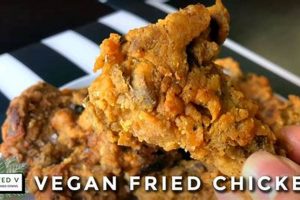This dish replicates the flavors and textures of a popular Chinese-American cuisine item, but substitutes animal products with plant-based alternatives. Typically, protein sources such as tofu, seitan, or tempeh are coated in a batter, fried or baked, and then tossed in a sweet and savory sesame-based sauce.
The creation appeals to individuals adhering to plant-based diets, offering a familiar culinary experience without compromising ethical or dietary principles. Its rise in popularity reflects a broader trend towards conscious consumption and the increasing availability of meat alternatives. The preparation also showcases the adaptability of classic recipes to accommodate evolving dietary preferences.
The following sections will explore different aspects of this plant-based adaptation, including ingredient selection, preparation techniques, and nutritional considerations. Variations on the recipe and regional differences will also be discussed.
Preparation Guidance
Achieving optimal results in replicating the classic dish requires careful attention to specific details. The following points provide guidance for successful creation.
Tip 1: Protein Preparation: When using tofu, press firmly to remove excess water. This enhances texture and allows for better sauce absorption. Seitan should be prepared to a firm consistency, avoiding a rubbery texture.
Tip 2: Batter Consistency: The batter should be thick enough to coat the protein thoroughly, but thin enough to ensure even cooking. A mixture of flour, cornstarch, and baking powder generally yields a light and crispy coating.
Tip 3: Cooking Method Selection: Baking offers a lower-fat alternative to frying. If frying, maintain a consistent oil temperature (approximately 350F or 175C) to achieve even browning.
Tip 4: Sauce Balance: The sauce should strike a balance between sweetness, savoriness, and tanginess. Adjust the quantities of soy sauce, sesame oil, rice vinegar, and sweetener (such as maple syrup or agave) to achieve the desired flavor profile.
Tip 5: Sauce Application: Toss the cooked protein in the sauce immediately before serving to prevent sogginess. Ensure the protein is evenly coated for maximum flavor impact.
Tip 6: Sesame Seed Toasting: Toast sesame seeds lightly before adding them to the dish. This enhances their aroma and flavor, contributing to the overall sensory experience.
Tip 7: Garnishing Considerations: Consider garnishing with sliced green onions or red pepper flakes to add visual appeal and subtle flavor complexities.
Adhering to these guidelines will contribute to a more flavorful and texturally satisfying final product. The successful replication of the dish hinges on careful execution of each stage of the preparation process.
The subsequent sections will delve into nutritional aspects and potential variations of this culinary creation.
1. Plant-based protein source
The selection of a plant-based protein source is fundamental to the identity of the dish as a plant-based alternative to traditional sesame chicken. It directly addresses the elimination of animal products and forms the structural core of the culinary adaptation. The chosen protein significantly impacts the texture, flavor profile, and overall nutritional value.
- Tofu: Versatility and Texture
Tofu, derived from soybeans, is a common choice due to its neutral flavor, which readily absorbs the sauce. Pressing tofu to remove excess moisture yields a firmer texture, enhancing its suitability for frying or baking. Its protein content and amino acid profile contribute to the nutritional adequacy of the dish. In this instance, the neutral flavour of the Tofu allows the sauces and seasoning to be the stand out of the dish.
- Seitan: Wheat-Based Mimicry
Seitan, composed of wheat gluten, offers a chewy, meat-like texture. This characteristic makes it a suitable substitute for chicken in terms of mouthfeel. Seitan is high in protein but may not be suitable for individuals with gluten sensitivities or celiac disease. Its ability to withstand high-heat cooking methods makes it appropriate for the sesame chicken replication.
- Tempeh: Fermented Soybean Complexity
Tempeh, also derived from soybeans, provides a more complex flavor profile due to the fermentation process. Its firm texture and nutty flavor can add depth to the dish. Like tofu, tempeh is a complete protein source. Its fermentation also introduces beneficial probiotics, potentially enhancing the digestive benefits of the meal.
- Jackfruit: fibrous and flavour absorption.
Jackfruit, especially when young and unripe, presents a stringy, fibrous texture that, when cooked, can mimic shredded chicken. Its mild flavour also makes it an ideal vehicle for strong sauces, as it readily absorbs seasoning. Commonly used as a meat substitute in many vegan dishes, jackfruit provides a good texture and flavour platform that is low in calories.
The selection of a plant-based protein source is not merely a matter of substitution, but a deliberate choice that shapes the sensory and nutritional characteristics of the dish. Each option presents unique advantages and considerations, influencing the final outcome and catering to diverse preferences and dietary needs. The successful integration of the protein source is critical to the overall success of replicating the classic sesame chicken experience in a vegan form.
2. Sesame-flavored sauce profile
The sesame-flavored sauce is the defining element that transforms a plant-based protein into a replica of a popular dish. Its composition and preparation dictate the authenticity and palatability of the final product. The sauce embodies a complex interplay of sweet, savory, and umami flavors, with sesame as the dominant aromatic component.
- Sesame Oil as the Flavor Foundation
Toasted sesame oil is crucial for imparting the characteristic nutty aroma and flavor. Its distinct profile distinguishes the dish and contributes to the overall sensory experience. Variations in sesame oil quality directly impact the sauce’s intensity and depth. A high-quality toasted sesame oil is essential for achieving an authentic flavor profile. In vegan sesame chicken the oil is what makes the dish close to the real thing.
- Soy Sauce for Umami and Saltiness
Soy sauce provides the foundational umami and saltiness, balancing the sweetness and acidity. Different types of soy sauce (light, dark, tamari) offer varying levels of intensity and complexity. Low-sodium soy sauce can be used to control the overall sodium content without sacrificing flavor. Tamari is a gluten-free substitute for soy sauce, accommodating dietary restrictions.
- Sweeteners for Balance and Texture
Sweeteners such as maple syrup, agave nectar, brown sugar, or rice syrup contribute to the sauce’s viscosity and balance the savory elements. The type and quantity of sweetener influence the overall sweetness level and textural characteristics. Maple syrup imparts a distinct flavor profile, while agave nectar provides a more neutral sweetness. The texture must be perfect in vegan sesame chicken.
- Vinegar for Acidity and Tanginess
Rice vinegar or apple cider vinegar adds acidity and tanginess, enhancing the complexity of the flavor profile. The acidity balances the sweetness and umami, creating a more harmonious flavor. Rice vinegar offers a milder acidity compared to apple cider vinegar. The vinegar is key to the sauce and therefore the vegan sesame chicken dish.
The integration of these components, in precise proportions, defines the success of the sesame-flavored sauce and its ability to elevate the plant-based protein into a recognizable rendition of sesame chicken. The sauce’s flavor profile is the key differentiator, bridging the gap between plant-based ingredients and the familiar culinary experience.
3. Crispy texture contrast
The presence of a crispy texture, juxtaposed against a tender interior, is a defining characteristic contributing significantly to the overall sensory experience of the vegan rendition of sesame chicken. This textural contrast enhances the dish’s appeal, mirroring the sought-after qualities of its non-vegan counterpart. The initial bite provides a satisfying crunch, yielding to a softer interior, preventing the experience from being monotonous. Without this textural element, the dish risks being perceived as bland or lacking in complexity, thus diminishing its resemblance to traditional sesame chicken.
Achieving this desired crispness often involves specific preparation techniques. For example, tofu requires thorough pressing to remove excess water, enabling it to crisp more effectively when fried or baked. A light batter, often composed of cornstarch and flour, encases the protein, providing a foundation for crisping. Optimal oil temperature during frying ensures uniform browning and crisping, while baking at a high temperature, perhaps with a brief broiling period, can also yield a satisfactory result. Furthermore, the timing of sauce application is critical; tossing the crisped protein in the sauce too early can lead to sogginess, negating the textural contrast. Successful vegan sesame chicken recipes prioritize methods that preserve the crispness until the point of consumption.
The significance of the textural contrast extends beyond mere aesthetics. It impacts the perceived palatability and enjoyment of the dish, influencing consumer acceptance. The absence of this contrast can be a critical failing point, leading to negative feedback. Consequently, recipe developers and food manufacturers invest considerable effort in replicating this texture through various techniques. The attainment of this textural characteristic is thus not merely a detail, but an integral component contributing directly to the overall success and appeal of vegan sesame chicken.
4. Nutritional considerations
Nutritional considerations are integral to the formulation and consumption of a plant-based version of the dish. While mirroring the flavor profile of the conventional dish is a primary goal, it is imperative to address the nutritional implications of substituting animal products with plant-based alternatives. This includes evaluating macronutrient distribution, micronutrient content, and potential deficiencies that may arise from omitting animal-derived ingredients. For example, the protein source, whether tofu, seitan, or tempeh, must provide a sufficient quantity and quality of amino acids to meet dietary requirements. Moreover, strategies to enhance the bioavailability of nutrients, such as iron and zinc, often found in lower concentrations or with reduced absorption rates in plant-based foods, must be incorporated. The high sugar and sodium content often associated with the traditional sauce presents another area requiring careful modification to promote a healthier nutritional profile.
The practical application of these considerations manifests in several ways. Recipes often emphasize whole-grain coatings over refined flours to increase fiber content. Vegetable additions, such as broccoli florets or bell pepper slices, contribute vitamins and minerals while enhancing satiety. Sodium levels are carefully monitored through the use of low-sodium soy sauce or by diluting the sauce with water or broth. Furthermore, the type and amount of sweetener used are carefully selected to minimize added sugars while maintaining the desired flavor. For instance, opting for a small amount of maple syrup over a larger quantity of refined sugar can provide a subtly different flavor profile while lowering the glycemic index. Some variations also include nutritional yeast to add a cheesy flavor and boost vitamin B12 content, a nutrient often lacking in plant-based diets. This is very important when it comes to vegan sesame chicken because of the lacking vitamins from animal source.
In summary, nutritional considerations are not merely an afterthought but a fundamental aspect of crafting a responsible and health-conscious plant-based adaptation of sesame chicken. Challenges lie in balancing taste and texture with nutritional adequacy, requiring a comprehensive understanding of food science and nutrition. The successful integration of these considerations contributes to a dish that is both palatable and promotes well-being, aligning with the growing consumer demand for nutritious and ethically sourced food options. This demonstrates that vegan sesame chicken can be more than just a tasty alternative; it can be a nutritionally sound choice.
5. Adaptability of recipe
The inherent adaptability of recipes is a critical factor in the proliferation and acceptance of plant-based alternatives to traditionally animal-derived dishes, such as “vegan sesame chicken.” The ability to modify and tailor existing recipes to accommodate dietary restrictions, ethical considerations, and regional preferences directly impacts the accessibility and widespread adoption of plant-based culinary options. Without this adaptability, the creation of palatable and culturally relevant substitutes becomes significantly more challenging. The connection between recipe adaptability and the specific example lies in the need to replace chicken with plant-based protein sources and adjust sauce ingredients to ensure the dish remains both flavorful and aligned with ethical and dietary guidelines.
Several factors contribute to the adaptability of the “vegan sesame chicken” recipe. Firstly, the protein component can be readily substituted with ingredients like tofu, seitan, tempeh, or even jackfruit, each offering distinct textural and nutritional profiles. Secondly, the sauce ingredients can be adjusted to accommodate varying degrees of sweetness, spiciness, or sodium content. For example, maple syrup or agave nectar can replace refined sugar, while low-sodium soy sauce can mitigate excessive salt intake. Thirdly, the addition of vegetables, such as broccoli or bell peppers, can enhance the nutritional value and visual appeal. Practical applications include variations catering to gluten-free diets (using tamari instead of soy sauce and gluten-free flours) or nut-free allergies (eliminating sesame oil or substituting it with a different oil). The recipe is adaptable enough to allow for adjustments based on available ingredients or regional tastes without losing the overall character of the dish.
In summary, the adaptability of recipes is not merely a desirable attribute but an essential component of popularizing dishes like “vegan sesame chicken.” It facilitates the creation of plant-based alternatives that are both accessible and appealing to a diverse range of consumers. The ability to customize the protein source, sauce ingredients, and vegetable additions enables the recipe to accommodate dietary restrictions, ethical considerations, and regional preferences. This adaptability addresses the challenges of replicating complex flavors and textures without animal products and contributes to the broader acceptance and integration of plant-based cuisine. Without this, vegan sesame chicken would be limited to a niche audience, rather than the expanding consumer base it currently enjoys.
Frequently Asked Questions
This section addresses common queries and concerns regarding the preparation, ingredients, and nutritional aspects of vegan sesame chicken.
Question 1: What protein sources are best suited for vegan sesame chicken?
Tofu, seitan, tempeh, and jackfruit are all viable options. Tofu offers a neutral flavor, while seitan provides a meat-like texture. Tempeh contributes a nutty flavor, and jackfruit provides a unique, fibrous texture that mimics shredded chicken when cooked. The optimal choice depends on personal preference and dietary requirements.
Question 2: How can crispiness be achieved without using traditional frying methods?
Baking or air-frying can provide a crispy texture with reduced oil. Thoroughly pressing tofu to remove excess water, using a cornstarch-based coating, and ensuring sufficient oven temperature (around 400F or 200C) are critical. A brief broiling period at the end of baking can enhance crispness.
Question 3: What are some healthy alternatives to refined sugar in the sauce?
Maple syrup, agave nectar, and brown rice syrup offer alternatives to refined sugar, adding sweetness with potentially lower glycemic impact. Using smaller quantities or combining sweeteners with fruit purees can further reduce the overall sugar content.
Question 4: How does the nutritional content of vegan sesame chicken compare to traditional sesame chicken?
Vegan sesame chicken typically has less saturated fat and cholesterol due to the absence of animal products. The protein source affects the total protein content; seitan is generally higher in protein than tofu. Paying attention to added sugars and sodium content is essential to ensure a healthy nutritional profile.
Question 5: Is gluten-free vegan sesame chicken possible?
Yes, gluten-free versions can be created by using tamari instead of soy sauce, which contains wheat. The coating should also be modified to use gluten-free flours, such as rice flour, tapioca starch, or a commercial gluten-free flour blend. Ensure all other ingredients are also certified gluten-free.
Question 6: How can the sodium content of the dish be reduced?
Using low-sodium soy sauce or tamari is a primary strategy. Diluting the sauce with water or broth can also help. Herbs and spices can be used to enhance flavor without adding sodium. A moderate approach to salt usage during the initial preparation of ingredients is critical.
In essence, the creation and enjoyment of vegan sesame chicken hinges on awareness of ingredient substitutions, careful preparation techniques, and consideration of nutritional aspects. Customization allows for adaptation to varied dietary needs and preferences.
The following section delves into regional and cultural variations of this widely adapted plant-based offering.
Conclusion
The preceding exploration of “vegan sesame chicken” reveals a complex interplay of culinary adaptation, dietary considerations, and cultural influence. A seemingly simple dish serves as a microcosm of larger trends in plant-based eating, ethical consumption, and the evolving landscape of food production. The successful replication of familiar flavors and textures using plant-derived ingredients underscores the potential for culinary innovation and the adaptability of traditional recipes to meet contemporary needs.
The significance of “vegan sesame chicken” extends beyond mere substitution; it represents a conscious effort to reconcile dietary preferences with ethical and environmental values. Further research into the optimization of plant-based protein sources, flavor enhancements, and nutritional fortification will undoubtedly refine the dish and its counterparts. Continued consumer demand and culinary creativity will drive the future evolution of this and other plant-based alternatives, solidifying their place in the global food ecosystem.







